Areola and Nipple Tattoo: The Ultimate Guide
Find out all you need to know about 3D nipple tattoos after mastectomy. How is a nipple tattoo done, how much does it cost, healing, aftercare, risks, and more.
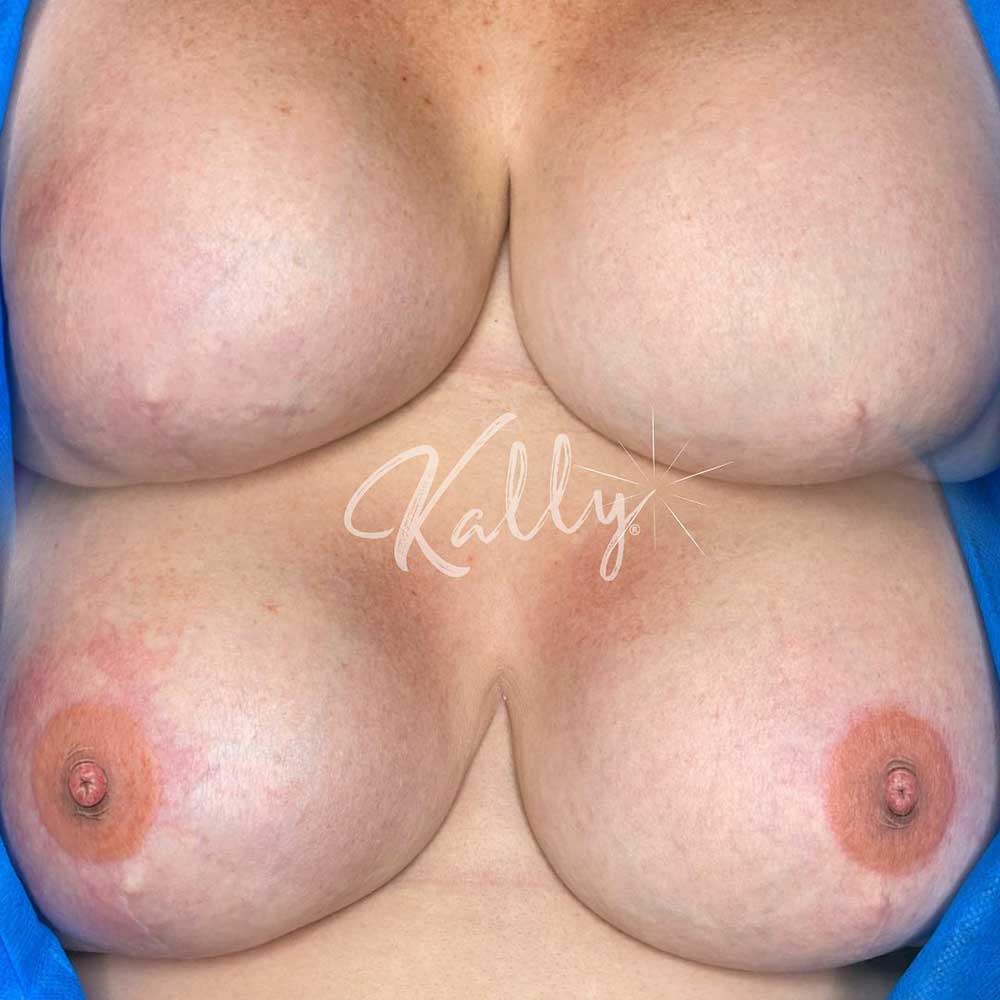
Image source : PMUhub
Explore more areola and nipple tattoo topics
Last updated in October 2023.
Breast cancer treatment is a hard, long, and invasive process, and breast cancer survivors are true heroes. As part of the treatment, many have to go through unilateral or bilateral mastectomy, losing their natural breasts.
But the struggle doesn’t end there; in order to regain their confidence, most of them seek breast reconstruction, and the final step is getting one or both nipple tattoos after mastectomy.
PMUHub brings you a thorough guide through the 3D nipple tattoo.
ABOUT THE AREOLA AND NIPPLE TATTOO TREATMENT
What Is an Areola and Nipple Tattoo?
Also called areola and nipple micropigmentation, it’s the final step of breast reconstruction.
3D nipple tattoos after mastectomy give the reconstructed nipple back the color of a natural nipple, and can give the areola – the circular stretch of pink skin around the nipple – the illusion of natural texture.
If you’ve had a nipple reconstruction surgery, or a dermal nipple implant and already have the 3D nipple, the tech will just add color to it and it’ll look just like a natural nipple.
The can also be done on flat skin, in cases where the nipple mound has not been reconstructed.
If you haven’t had the nipple reconstructed, the tech will do a 3D nipple tattoo which will give hyperrealistic results. Of course, the tattoo alone can’t recreate the texture, but it can look very realistic if the tech is skilled enough.
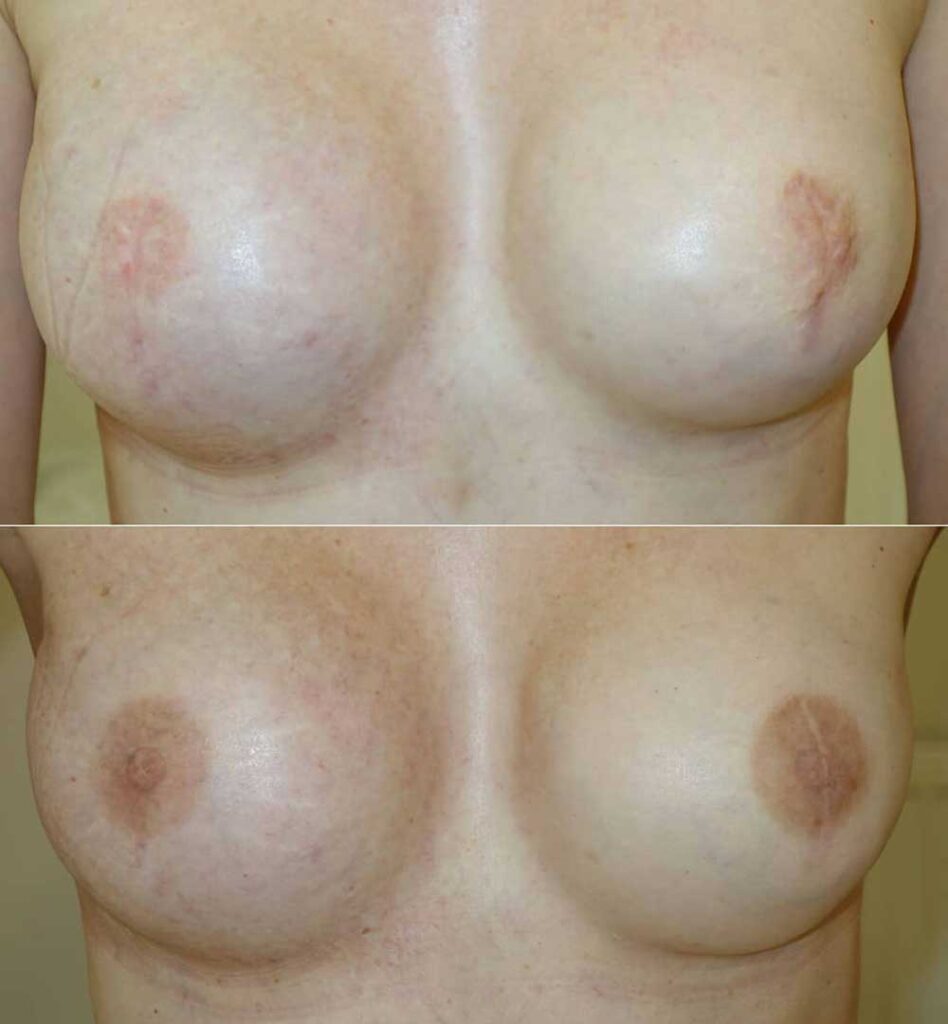
This treatment is a form of paramedical micropigmentation, and it can be combined with scar micropigmentation camouflage in order to give the most natural look possible to the breast.
Areola paramedical micropigmentation is done with an elaborate tattooing technique that creates a 3D effect. An electric device is used to implement color into the skin.
The color can be either regular tattoo ink, or permanent makeup pigment.
With tattoo ink, the results last for years, possibly forever, with slight fading and color change over time.
Permanent makeup pigments are formulated to fade after a certain time, providing the possibility of color refreshers instead of letting the ink turn. In this case, the results last 3-5 years, over which period they gradually fade.
PMUHub Note
In case you’ve had nipple reconstruction surgery, you have to wait 3-6 months before you can get a nipple and areola tattoo. Otherwise, there’s a chance the tattooing will flatten the nipple.
Who Is Areola and Nipple Tattoo For?
- For people who had to go through unilateral or bilateral mastectomy, losing their natural breasts, and are having breast reconstruction, after which they get one or both nipple and areola tattoos.
- People who are going through gender affirmation surgery.
- People who suffer from a condition called athelia, which means they were born without one or both nipples.
- People who are looking to enlarge the outer areola area, due to personal preferences.
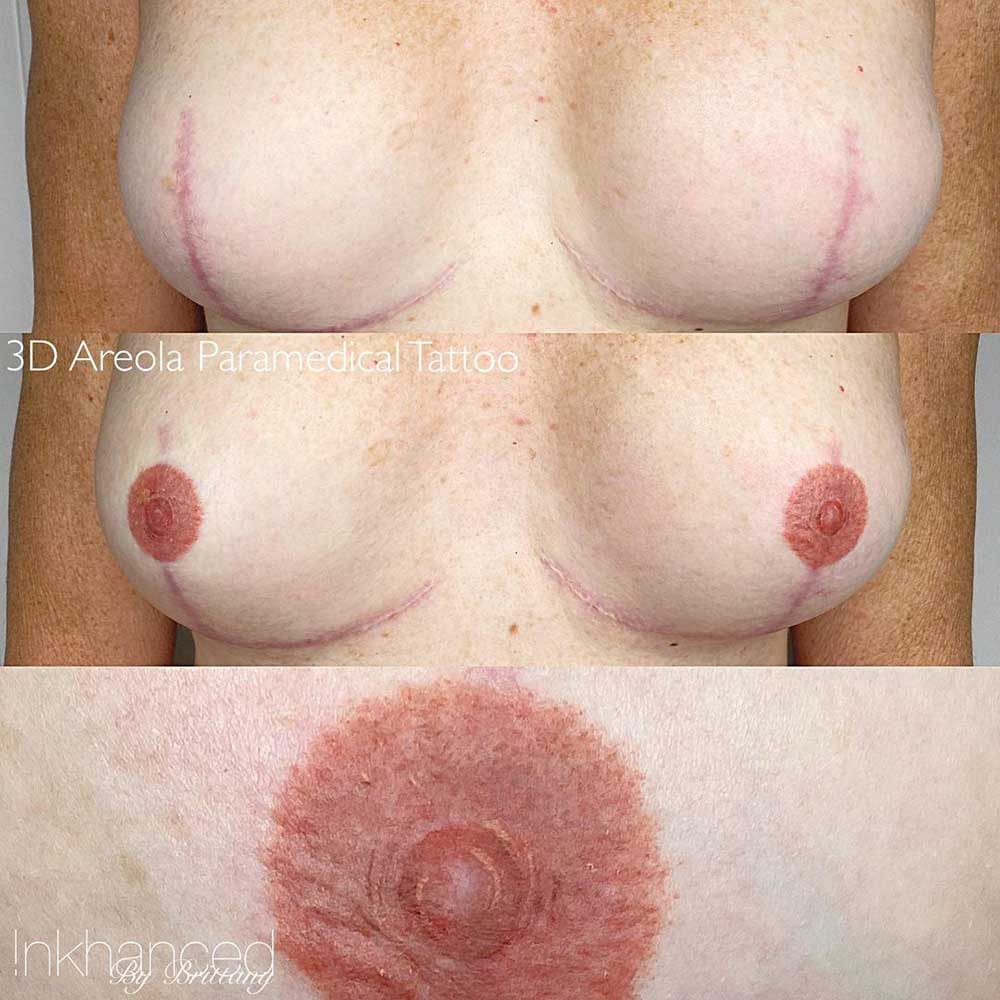
What Happens at the Nipple Tattoo Appointment?
Step 1 – Numbing
The appointment usually starts with numbing. A topical anesthetic is applied to minimize the discomfort. In case your mastectomy has damaged the nerves in the area and your breast(s) are numb as is, this step can be skipped.
NOTE: In some states, the micropigmentation tech isn’t allowed to apply numbing before tattooing. Contact a local salon and check.
Step 2 – Outlining
It takes some time for the numbing to kick in, and the tech will use this time to measure and outline the nipples. In case you are only getting 1 side tattooed, they’ll do their best to match the existing nipple in terms of shape, size and color.
If they’re recreating them both from scratch, you can choose the shape, size and shade.
Step 3 – Micropigmentation
The pigments are prepared (they can be custom mixed), and the tattooing starts.
The tech will use an electric device with multiple thin needles to implement pigments. They’ll go back and forth, building up the color in several passes.
They will use a range of techniques to create a 3D effect.
Step 4 – Cleaning and Further Instructions
Once the tattooing is done, they’ll clean the area and wrap it up in sterile gauze to protect it from rubbing against our clothes on your way home.
They’ll give you aftercare instructions you will need to follow, and give you a moisturizing balm to use during healing.
Step 5 – Follow-Up
Most techs perform the procedure in 2 sessions, so you will come back in for a follow-up 6-8 weeks later.
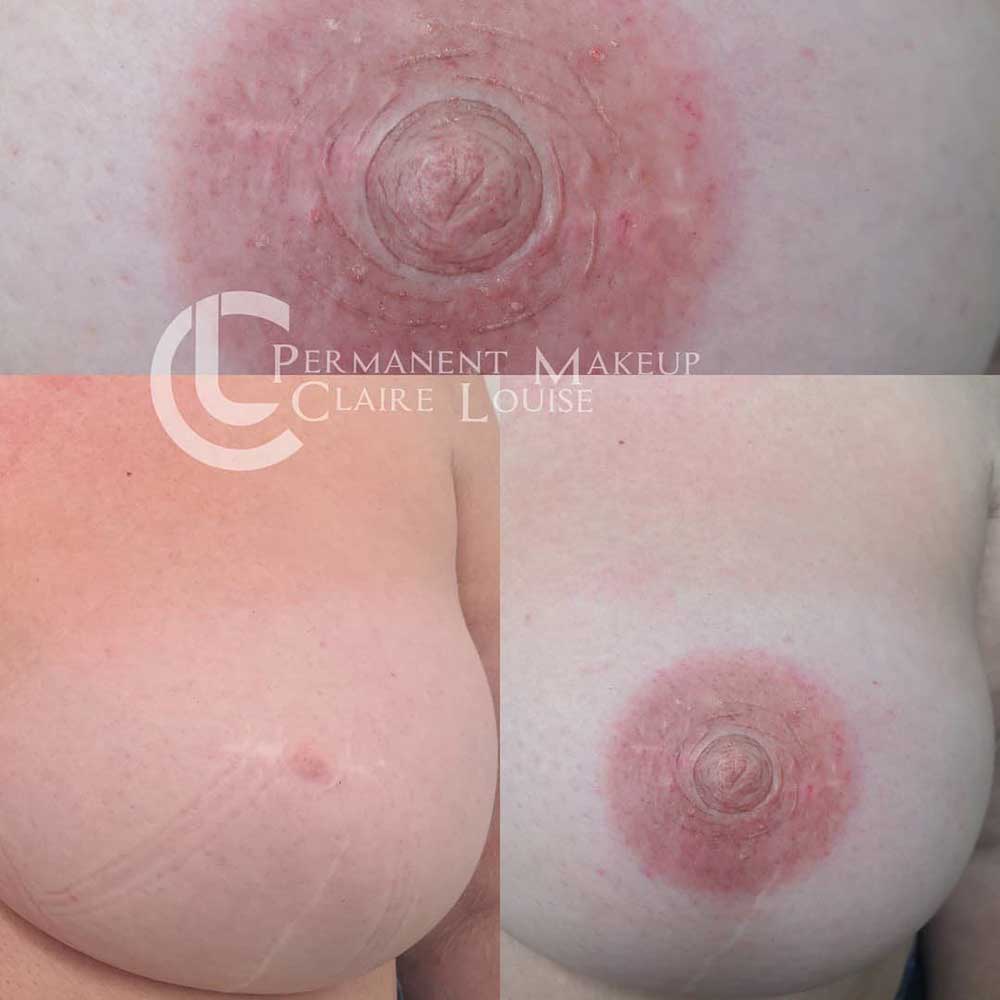
How Long Does the Nipple Tattoo Treatment Take?
The 3D nipple tattoo appointment lasts about an hour and a half if you’re getting only one side tattooed, or around 2-2.5 hours if you’re doing both sides.
Does Getting a Nipple Tattoo Hurt?
How much getting nipple tattoos after mastectomy hurts varies from person to person, but once reconstructed, it’s possible that your breasts are no longer as sensitive as they used to be. Thus, in most cases the pain level is quite low.
A numbing cream is applied to the area in order to numb the area further, so there shouldn’t be any pain involved.
That said, you may feel pressure and scratching. Patients with implants might feel a vibration through the implant during the procedure.
PREPARATION FOR THE NIPPLE TATTOO TREATMENT
Nipple Tattoo Consults
3D nipple tattoos after mastectomy are never done without consults.
The technician needs to assess the state of your breasts in order to tell you what you can expect. It’s a very customized treatment, so you need to discuss the desired outcome with them.
The price of the treatment is also most often determined at the consults.
This is also an opportunity to do a patch test to make sure you’re not allergic to the pigments or other products used during the procedure.
How Do I Prepare for the Nipple Tattoo Treatment?
There are certain activities and medication you should avoid in the weeks and days before your areola tattoo appointment if you want the treatment to go smoothly and get the best results possible.
- Don’t go sunbathing or tanning at least 2 weeks before the procedure. This can make your skin more sensitive and the color matching problematic.
- If you take blood-thinning medications, check with your GP if it’s okay to stop taking them for a few days before your appointment. They can increase bleeding and make the pigmentation difficult.
- Avoid alcohol, caffeine, ibuprofen, aspirin, and fish oil supplements for at least 24 hours prior to the treatment
- Don’t do any peels in the area at least 2 weeks before the treatment.
It’s also advisable to show up to your appointment in loose-fitting clothing. The area can be sensitive after the procedure and tight clothes may feel uncomfortable.
NOTE
As part of breast reconstruction, getting 3D nipple tattoos after mastectomy should be covered by insurance, at least partially.
This is a huge relief, but it probably entails dealing with a bunch of paperwork. Check with your insurance provider and the salon you’ve chosen what paperwork you need and what to do with it.
In case your insurance doesn’t cover an areola tattoo, you can ask around after techs who do free or heavily discounted nipple tattoos after mastectomy for cancer survivors. Many of them do.
NIPPLE TATTOO HEALING PROCESS
The Nipple Tattoo Healing Process Day by Day
Micropigmentation involves breaking the surface of the skin over and over again with a multi-needle device. So after each micropigmentation session, the skin needs some time to close up the wounds, and for the pigments to settle into it.
The recovery goes something like this:
Days 1-2
Right after the treatment, the area is red and swollen. This is normal for a few days, but if it doesn’t subside by day 5, contact your tech – you may be dealing with an infection.
You may also experience some pain and tenderness. Check with your tech if it’s okay to take a painkiller.
You may also notice the skin is oozing lymph, and maybe even some blood. Clean the area by gently blotting it.
Days 3-7
A scab will form over the treated skin. The area will be covered with a thin crust film, and it’ll probably feel itchy and tight.
Don’t pick at the scabs! You can relieve the discomfort with a moisturizer prescribed by your tech.
Days 7-14
The scab will peel off.
The peeling should start by day 7, and it can last as long as a week. Some clients even experience a second peel, less dramatic than the first one, but equally annoying.
The no. 1 rule you have to remember is not to pick the flakes and the scabs. You have to let them fall off on their own. Ripping them off will take patches of pigment and you’ll end up with patchy results. You also risk catching an infection.
Days 15-42
Surface healing is considered over once the peeling stops, but internal healing takes 6-8 weeks.
That’s how long it takes for the pigments to settle and for the tissue underneath the surface to recover.
Once the 6 weeks have passed, you can book a follow-up with your tech where any imperfections that may have emerged during healing can be fixed.
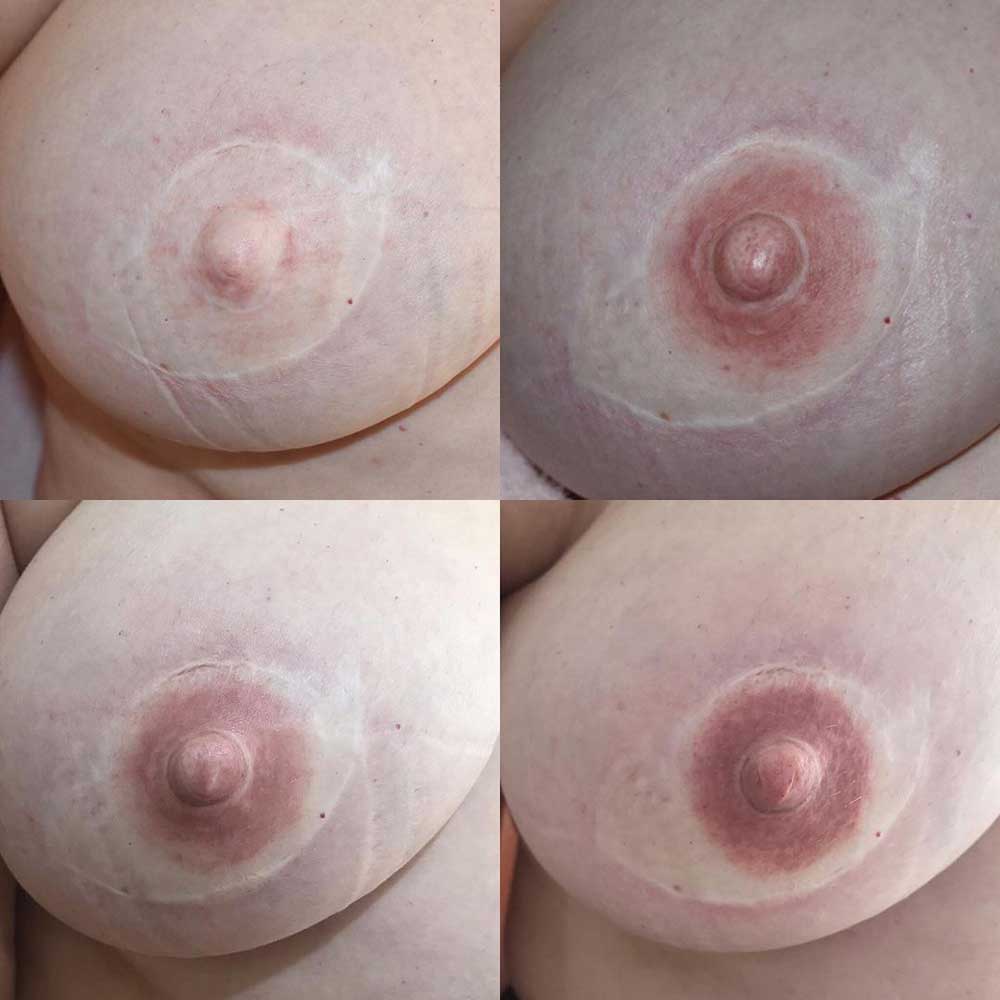
NIPPLE TATTOO AFTERCARE
What Does the Nipple Tattoo Aftercare Involve?
During the healing period, you need to follow an aftercare routine to make sure your areola tattoo heals properly and you avoid infections:
- In the first few days, clean the area from built-up lymph as instructed by your technician.
- Try to keep the area dry until day 3. If you get the area wet, blot it dry with sterile gauze. If you have to take a shower, make it short and try to avoid getting your breasts wet as much as possible, and dry them as soon as possible. Don’t point the shower head towards them!
- No rubbing – you can ruin the results.
- Your technician will most likely prescribe a moisturizing balm you should apply to your nipple tattoo a few times a day throughout the healing period. Use it as instructed. It will keep the area safe from contamination and ease the healing process.
- Don’t get any product except for the prescribed moisturizer on the treated area for 7-10 days. No soap, no shower gel, no shampoo, no nothing.
- Repeat after us – you will not pick at the scabs!
- Avoid the following for at least 2 weeks: sunlight exposure, tanning beds, swimming in the ocean or swimming pools, saunas, steam baths, excessive sweating.
NIPPLE TATTOO FADING
How Long Does the Nipple Tattoo Last?
If you get a tattoo done with traditional tattoo ink, you can expect the results to last for many, many years, with some fading and color change.
If you get it done with cosmetic pigments, the results will last anywhere from 3 to 5 years, potentially even longer, but the will fade gradually and the color shouldn’t turn. The longevity in any specific case will depend on:
- Your skin type. Micropigmentation fades more quickly on oily skin.
- Your age.
- Your lifestyle. Frequent exposure to sunlight, salt and pool water accelerates pigment fading. So does smoking and frequent alcohol intake.
- Your skincare. Certain skincare ingredients accelerate pigment fading, Although these are primarily found in facial products, they can feature in body lotions, too.
- Your system. Some systems break down pigments very quickly, while others retain them for a very long time.
NIPPLE TATTOO TOUCH UP
When Should I Get My Areola Tattoo Touched Up?
Most technicians insist on the first touch up being done 6-8 weeks after the initial micropigmentation. This extra session ensures your 3D nipple tattoo lasts as long as possible, and it can perfect the shape and color.
During healing, it’s not uncommon for some minor patchiness to emerge – this is also fixed at the first touch up.
After that, most clients like to get their nipple tattoo touched up once a year if it was done with cosmetic pigments. This keeps the color looking fresh and even.
How often you’ll get touch ups depends entirely on you. If you don’t get any, your areola tattoo will fade out completely after 3-5 years.
If the tattoo was done with regular tattoo ink, it’s hard to say when and if it will need a color boost. You can consult a tech when you feel like the color needs a refresher.
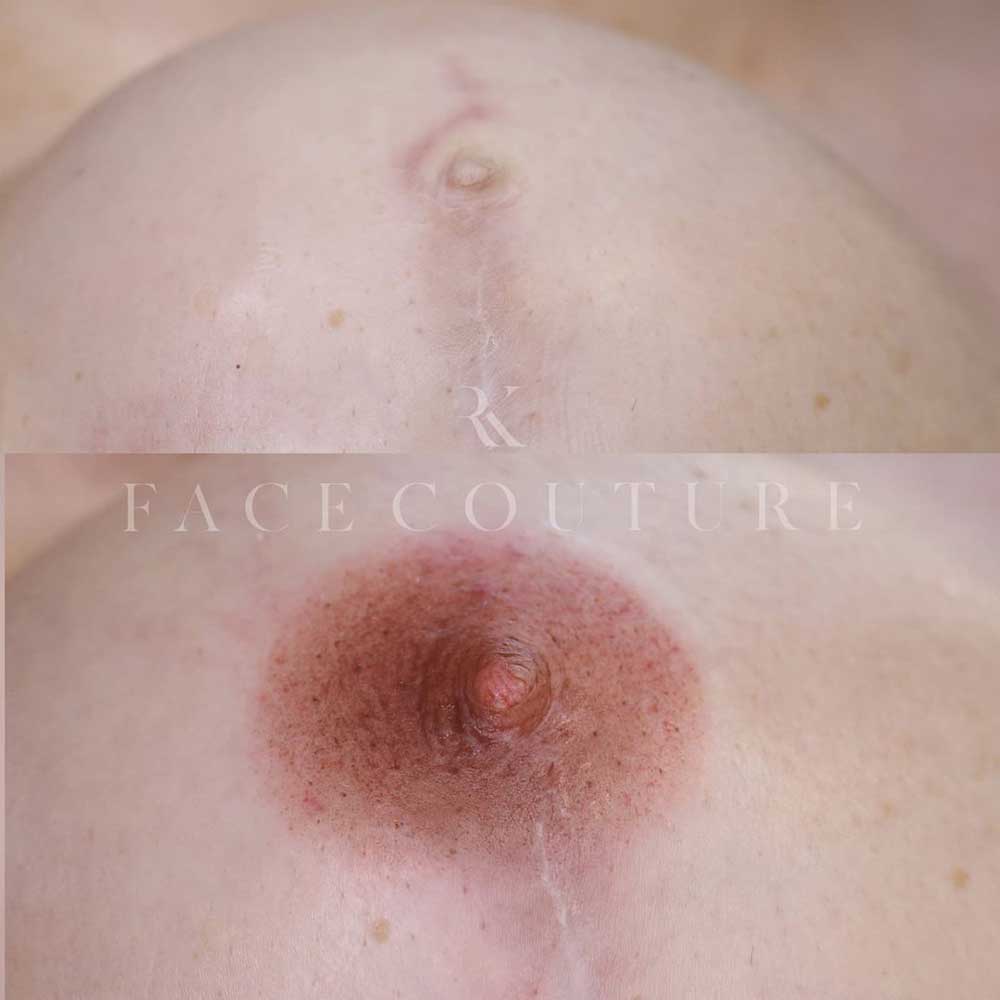
NIPPLE TATTOO RISKS
Are There Any Risks to Getting an Areola Tattoo?
The areola micropigmentation treatment is generally considered non-invasive, and if it’s done by a trained and certified technician, it should be completely safe.
That said, there are certain risks, however minor.
- Infection. If the environment where the treatment is performed isn’t sterile, or if you let the area get contaminated during healing, you risk developing an infection. Excessive redness and swelling after day 3 as well as pus can point to an infection.
- Allergies. The pigments and the numbing cream used during the procedure can cause allergic reactions. Do a patch test beforehand to be safe.
- Pigment migration. A reconstructed breast probably features scars on its surface. Tattooing on skin with uneven texture has to be done very meticulously, otherwise, the pigments may migrate into scar tissue, or bleed out of the desired outline.
- Scarring. Since the skin is penetrated over and over again, there’s a risk of permanent scarring. However, this shouldn’t happen if the tech is experienced. If you’re generally prone to keloid formation, the risk is greater.
- Nipple flattening. If you had your nipple reconstructed from transplanted skin, the tattooing process may flatten it. You need to wait 3-6 months after reconstruction to get a tattoo, and the tech should go slow and gentle.
To avoid these complications, never go to an uncertified, self-taught technician!
NIPPLE TATTOO FINANCING
Is a Nipple Tattoo Covered by Insurance?
The Women’s Health and Cancer Rights Act of 1998 (WHCRA) is a federal law that requires group health plans and health insurance companies that offer mastectomy coverage to also pay for reconstructive surgery after mastectomy.
The coverage should include all stages of reconstruction with the aim of achieving symmetry between the breasts.
Therefore, 3D nipple tattoos after mastectomy should be, and often are, covered by most insurance providers. If they’re not, you can try to find an artist who does free treatments for cancer survivors – many do.
You can find more information about WHCRA at the U.S. Department of Labor and the Centers for Medicare & Medicaid Services.
NOTE
Insurance coverage and criteria vary by state, so it is best to check with your insurance provider first. Your tattoo artist will give you a receipt that you could submit to your insurance company.
NIPPLE TATTOO COST
How Much Does a Nipple Tattoo Cost?
The cost of nipple and areola micropigmentation differs from artist to artist, and from state to state.
If the treatment is done on both breasts, it’s more expensive than just one.
It also depends on the extent of existing scarring, and that’s why most salons only give a quote upon consults.
The average price is around $500 for one nipple, and $815 for both.
The price of the first touch up is usually included in the initial price.
But again, most technicians only determine the price upon assessing the area.
Performing the treatment on heavily scarred tissue can be difficult, and that’s why the price may be significantly higher than the average.
AREOLA AND NIPPLE TATTOO – MAIN TAKEAWAYS
Microblading is the most popular form of permanent makeup for a reason.
It saves time, boosts your confidence, fixes any small brow imperfections you may be feeling self-conscious about. And all that without reapplying, running, smudging, or worrying about your brows for up months or years!
This treatment can truly change your life, but make sure you always go to a trained, certified artist in order to stay safe and get fabulous results.
weekly insight into PMU insdustry
Subscribe to our FREE newsletter. 100% good stuff.

support us so we can keep providing you with free education , information and inspiration.
